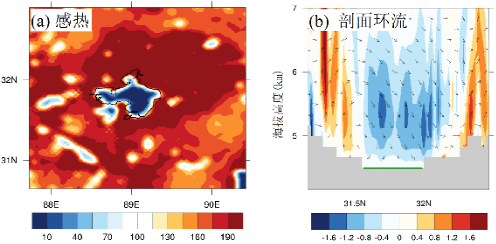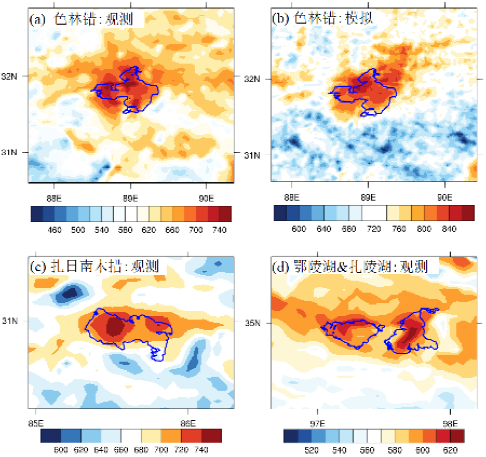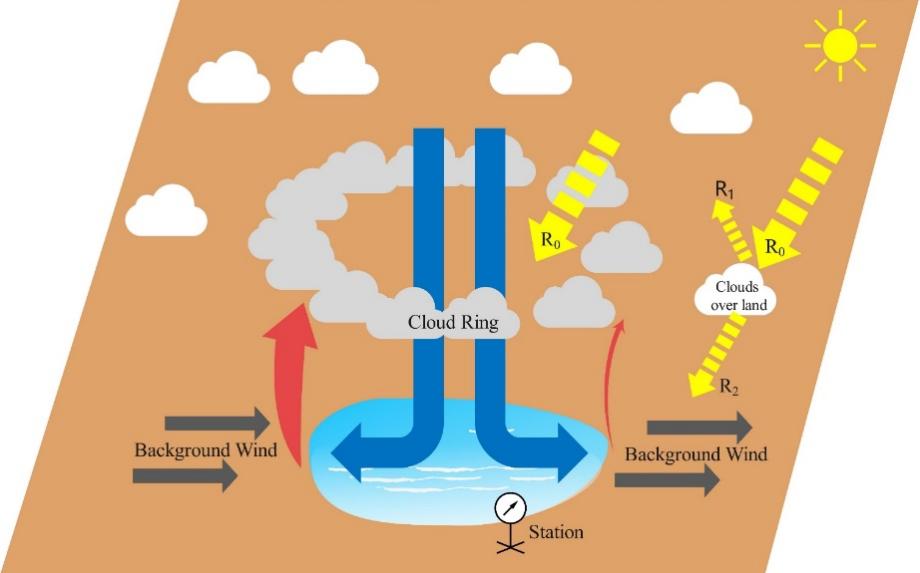The Tibetan Plateau (TP) known as “Asia’s Water Tower” is one of the regions in China where lakes are most densely distributed. Recent decades have seen obvious changes in the water levels and areas of lakes on the TP, drawing special attention to the hydrologic budget process of the plateau lakes. Lake surface evaporation, as an important part in water balance, is affected by the radiation reaching the lake surface, which is largely determined by the cloud amount/cloud occurrence frequency (COF) over the lake. Due to the lack of lake surface observations, the radiation observed lakeshore is usually used as a driver in the present estimation of lake evaporation. This practice is premised on the proximity between lakeshore radiation and lake surface radiation. However, it is not clear how much uncertainty in lake evaporation estimation would be induced by such a treatment, and therefore further investigations are needed.
With regard to the above scientific question, Professor Yang Kun’s Research Group of the Department of Earth System Science (DESS), Tsinghua University, based on satellite observations and model simulation, explores the impact of lakes on clouds and radiation on the TP, offering a new approach to the exploration of lake energy and water balance.
Satellite observations show that during the warm season (May-September), the daytime cloud occurrence frequency (COF) on lakes is obviously lower than lakeshore COF, forming hollow structures, and there are ring-shaped cloud systems around lake, matching well with shorelines, namely "cloud holes" and "cloud rings" (Fig. 1). Such hollow structures of COF are generally found in plateau lakes over 300km⟡, but are rare in low altitude lakes.

Fig. 1 Observed (H8) Daytime cloud occurrence frequency around (a) Selin Co, (b) Zhari Nam Co, and (c) Ngoring (east) and Gyaring (west) Lake during warm seasons in 2016–2018. The yellow lines denote lake boundaries.
To explore the influence mechanism of lakes on COF, the Research Group has carried out high-resolution simulation with the help of a lake-air coupling model, taking Selin Co (the largest lake in Tibet) as an example. The results show that the sensible heat of the lake surface is much lower than that of lakeshore surface, and the strong sensible heat gradient between the lake and the lakeshore drives the formation of land-lake breeze. The downdraft branch inhibits cloud formation over the lakes, while the updraft branch causes convection to form clouds over lakeshores. which leads to the formation of "cloud holes" and "cloud rings" in Fig.

Fig. 2 (a) Simulated daytime sensible heat in and around Selin Co (W/m2); and (b) meridional circulation averaged from west to east of Selin Co. during July 2017. The colors denote vertical speeds (0.1 m/s).
The hollow structure of COF above the lake has obvious influence on the daytime radiation balance of the lake surface. On the one hand, fewer clouds make more shortwave radiation reach the lake surface than the surrounding land (Fig. 3). For example, the shortwave radiation of Selin Co can be more than 100 W/m2 higher than the surrounding land. On the other hand, the downward longwave radiation reaching the lake surface is reduced compared with the surrounding land, but is less than 10 W/m2 lower. On the whole, the total radiation reaching the lake surface can be about 100 W/m2 higher than the surrounding land. The whole mechanism process is shown in Fig. 4. At the same time, this also means that the radiation observed on the land surrounding the lake cannot represent the radiation received by the lake; and this radiation difference caused by the difference of COF between lake and land shows that the lake evaporation will be underestimated by a lake model driven by lakeshore station observations of radiation. In the absence of accurately observed radiation on the lake surface, it is suggested to use high-resolution satellite radiation products as a substitute.

Fig. 3 (a) Observed (H8) and (b) Simulated surface shortwave radiation (W/m2) around Selin Co during July 2017. Long-term (May–September 2016–2018) observation (H8) of surface shortwave radiation (W/m2) for (c) Zhari Nam Co and (d) Ngoring and Gyaring Lake. The blue lines denote lake boundaries.

Fig. 4 The schematic of lake influences on clouds and radiation via lake breeze. The presence of lake breeze reduces daytime clouds above lakes and increases shortwave radiation reaching lake surfaces.
The related research has been published as a paper titled “Observation and Process Understanding of Typical Cloud Holes Above Lakes Over the Tibetan Plateau” in Journal of Geophysical Research: Atmospheres. Yao Xiangnan, a doctoral graduate of the DESS, Tsinghua University, is the first author of the paper, and Professor Yang Kun of the DESS is the corresponding author. Other co-authors of the paper include Researcher Husi Letu of the Aerospace Information Research Institute, Chinese Academy of Sciences, Associate Researcher Zhou Xu of the Institute of Tibetan Plateau Research, Chinese Academy of Sciences, Doctor Wang Yan of the Institute of Geographic Sciences and Natural Resources Research, Chinese Academy of Sciences, Doctor Ma Xiaogang and Professor Lu Hui of the DESS, Tsinghua University, and Researcher La Zhu of Tibet University. This work was supported by the National Natural Science Foundation of China.
Full-text link of the paper: https://agupubs.onlinelibrary.wiley.com/doi/10.1029/2023JD038617
Written by Yao Xiangnan
Edited by Wang Jiayin
Reviewed by Yang Kun and Zhang Qiang